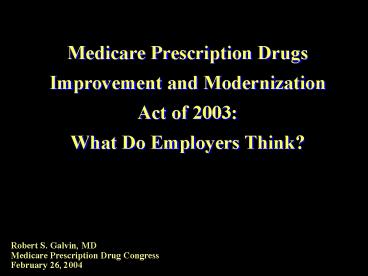Robert S. Galvin, MD - PowerPoint PPT Presentation
Title:
Robert S. Galvin, MD
Description:
The Devil (And The Angel) Is In The Details. Details of Actuarial Equivalency' FASB Guidance. HSA Design. Rules for PBMs and Health Plans. 5. Employer Options ... – PowerPoint PPT presentation
Number of Views:12
Avg rating:3.0/5.0
Title: Robert S. Galvin, MD
1
Medicare Prescription Drugs Improvement and
Modernization Act of 2003 What Do Employers
Think?
Robert S. Galvin, MD Medicare Prescription Drug
Congress February 26, 2004
2
What The Bill Isnt
Perfect
3
What The Bill Is
The Triumph Of Experience Over Hope
Apologies to Samuel Johnson
- Government Can Act on Health Care
- Employers Included in Dialogue
- Favors Competitive / Market Approach . . . But
With Safety Net - Pushes Transparency / Quality Agenda
- Encourages Consumerism . . . Creates Possibility
of New Solutions
4
The Devil (And The Angel) Is In The Details
- Details of Actuarial Equivalency
- FASB Guidance
- HSA Design
- Rules for PBMs and Health Plans
5
Employer Options
- Drop Retiree Coverage Government Safety Net
- Take Employer Subsidy
- Coordinate With Medicare As Primary
6
Why Is No One Talking About the U Word?
Cost Price x Use
Price
Use
Mix
99 5 10 8 00 2 12 4 01 5 6 3 02 6 9
4 03 5 4 4
7
Cost and Quality Must Be Integrated
- Paying More Means Using Less . . . Without
Regard To Quality - More Gradual Change Avoids Quality Problems
8
Why Is No One Talking About the Q Word?
Use Price Sensitivity x Compliance x
Quality (Appropriateness)
Sigma 2.75 Defect 11
Risk Days
Days Where Necessary Therapy Was Lacking 118,206
Days Where Unneeded Therapy Was
Provided 8,904,000
Therapy Dispoused 84,000,000
9
What Kind of Risk?
- Over Utilization
- Overuse
- Duration
- Duplication
- Misuse
- Drug-Drug
- Drug-Disease
Under Utilization
56.1
42.6
1.2
10
Quality Saves Money
Source of Savings (Approx) by Defect
Results
Conflicts Tracked 81,423 Changes Made
29,864 Change Rate 37
Duration 40 Drug Disease 25 Overuse
25 Drug Interaction 5 Duplicate Therapy
5
03 10MM Saved 04 Send Letter to Physician
and Patient
11
Wall Street Journal December 4, 2004
12
A Market Approach to Costs
Employers believe that consumer pressure is a
powerful, underutilized lever for improving
quality and efficiency. They believe that higher
quality and lower cost will result if consumers
spend more of their own money for services they
believe are high quality, and if providers
respond by improving their performance. For this
strategy to succeed, consumers will have to be
activated to seek more efficient, higher quality
care and physicians will have to be rewarded for
delivering it. Sounding Board NEJM, September
19, 2002
- Transparency
- Incentives and Rewards
- Focus on Quality and Efficiency
13
Efficiency and Quality Create Value
Hospital B
Hospital A
Hospital C
Hospital E
Hospital D
Hospital F
Hospital G
14
National Centers of Excellence An Example































